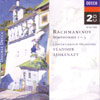Rachmaninov Symphonies Nos 1-3
View record and artist detailsRecord and Artist Details
Composer or Director: Sergey Rachmaninov
Genre:
Orchestral
Label: Double Decca
Magazine Review Date: 7/1996
Media Format: CD or Download
Media Runtime: 140
Mastering:
Stereo
DDD
Catalogue Number: 448 116-2DF2

Tracks:
| Composition | Artist Credit |
|---|---|
| Symphony No. 1 |
Sergey Rachmaninov, Composer
(Royal) Concertgebouw Orchestra, Amsterdam Sergey Rachmaninov, Composer Vladimir Ashkenazy, Conductor |
| Symphony No. 2 |
Sergey Rachmaninov, Composer
(Royal) Concertgebouw Orchestra, Amsterdam Sergey Rachmaninov, Composer Vladimir Ashkenazy, Conductor |
| Symphony No. 3 |
Sergey Rachmaninov, Composer
(Royal) Concertgebouw Orchestra, Amsterdam Sergey Rachmaninov, Composer Vladimir Ashkenazy, Conductor |
Author:
Ashkenazy has made few more distinguished discs as conductor than these Rachmaninov symphony recordings of the early 1980s. They are to that decade what Ormandy’s were to the 1960s or Previn’s to the 1970s and their appearance in this two-disc format has the obvious attraction of economy. The downside of the repackaging is that you have to put up with a change of disc half-way through the Second Symphony and lose several shorter orchestral works in which Ashkenazy arguably has no peer, notably the Symphonic Dances and the Isle of the dead, both included in the three-disc alternatives listed above.
Perhaps, like me, you have already opted for the Previn box. In that case you can now afford to supplement it with Ashkenazy’s more opulently recorded, more overtly excitable symphonic integrale. Previn is the most natural but not always the most electrifying of Rachmaninov interpreters and many will find Ashkenazy preferable, particularly in No. 1. Although some of Ashkenazy’s speeds seem unnaturally pressed – he fairly tips us into the first movement reprise having declined to cap the climax with unvalidated bells – the excitement is infectious. Only the finale’s famous fanfare comes as something of a disappointment, the inverted commas rather too deliberately placed I felt, though I see this didn’t worry EG or IM. Previn’s LSO are not at their best in the Larghetto (placed third), but in the corresponding movement of the Second Symphony the boot is on the other foot. Not that Ashkenazy isn’t convincing too – so long as you can forget the Previn. Ashkenazy’s volatile approach is at its most extreme in the Third, the mood much less autumnal than it usually is (and perhaps should be), with the fruity Concertgebouw brass unconstrained. Such an unashamedly episodic rendering of the score has its drawbacks, but the virtuosic energy and romantic gush are hard to resist.
Throughout the cycle, the players are unfailingly alert and the recordings sound very well indeed. While the big acoustic muddles some detail, hall resonance helps distract the ear from the slightly steely quality of the strings (most noticeable in No. 2). Like the recently reissued Ashkenazy/Previn concerto cycle (Decca, 2/96) this is an exceptional bargain.'
Perhaps, like me, you have already opted for the Previn box. In that case you can now afford to supplement it with Ashkenazy’s more opulently recorded, more overtly excitable symphonic integrale. Previn is the most natural but not always the most electrifying of Rachmaninov interpreters and many will find Ashkenazy preferable, particularly in No. 1. Although some of Ashkenazy’s speeds seem unnaturally pressed – he fairly tips us into the first movement reprise having declined to cap the climax with unvalidated bells – the excitement is infectious. Only the finale’s famous fanfare comes as something of a disappointment, the inverted commas rather too deliberately placed I felt, though I see this didn’t worry EG or IM. Previn’s LSO are not at their best in the Larghetto (placed third), but in the corresponding movement of the Second Symphony the boot is on the other foot. Not that Ashkenazy isn’t convincing too – so long as you can forget the Previn. Ashkenazy’s volatile approach is at its most extreme in the Third, the mood much less autumnal than it usually is (and perhaps should be), with the fruity Concertgebouw brass unconstrained. Such an unashamedly episodic rendering of the score has its drawbacks, but the virtuosic energy and romantic gush are hard to resist.
Throughout the cycle, the players are unfailingly alert and the recordings sound very well indeed. While the big acoustic muddles some detail, hall resonance helps distract the ear from the slightly steely quality of the strings (most noticeable in No. 2). Like the recently reissued Ashkenazy/Previn concerto cycle (Decca, 2/96) this is an exceptional bargain.'
Discover the world's largest classical music catalogue with Presto Music.

Gramophone Digital Club
- Digital Edition
- Digital Archive
- Reviews Database
- Full website access
From £8.75 / month
Subscribe
Gramophone Full Club
- Print Edition
- Digital Edition
- Digital Archive
- Reviews Database
- Full website access
From £11.00 / month
Subscribe
If you are a library, university or other organisation that would be interested in an institutional subscription to Gramophone please click here for further information.




